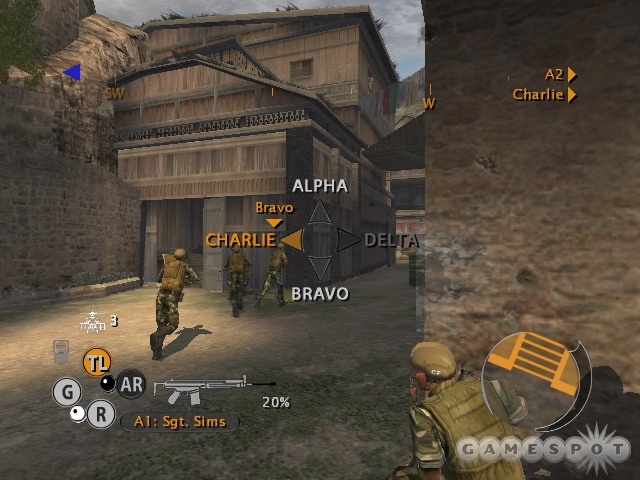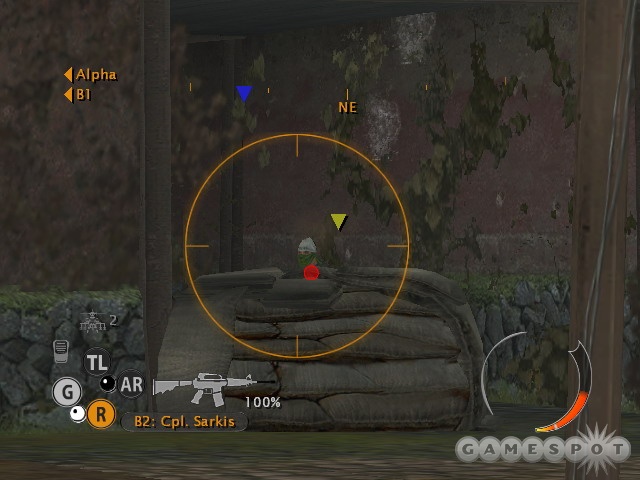Full Spectrum Warrior: Ten Hammers Hands-On
We get our hands on a near-complete version of Pandemic's Full Spectrum Warrior sequel and check out its story-driven campaign.
Currently in development at Pandemic Studios, Full Spectrum Warrior: Ten Hammers is the sequel to 2004's Full Spectrum Warrior--a military-themed tactical shooter that was originally developed for the US Army and later enhanced for civilian consumption. Although it looked and sounded like an action game, Full Spectrum Warrior tested your gray matter far more than your reflexes, because while you could control your squads' movement, you were never afforded direct control of their firearms. Ten Hammers promises to offer a more action-oriented experience than its predecessor, and having recently had the opportunity to spend some time with a work-in-progress version of the game, we can report that it is sacrificing none of the original's tactical gameplay to do so. In fact, your tactical options and controls in Ten Hammers will be vastly superior.
If you played Full Spectrum Warrior, you'll know that you spent much of the game commanding two squads--Alpha and Bravo--composed of four soldiers each. You might also remember that practically all of the game's combat situations tasked you with getting your men behind cover and then using a combination of cover fire, flanking maneuvers, frag grenades, and smoke grenades to get the better of your enemies, who were also behind cover. You'll still be able to do all of those things in Ten Hammers, and occasionally you'll need to do little else to complete a mission objective or overcome a certain group of enemies. There are plenty of situations in Ten Hammers that require more advanced strategies, though, and the good news is that the game doesn't look to be any less accessible as a result.
Ten Hammers retains the same elegant control setup as Free Spectrum Warrior, which lets you move and perfectly position your soldiers simply by moving icons on the screen that will adhere to walls, as well as objects that you can use for cover when they get close. New for Ten Hammers is a small radarlike device in the lower right corner of the screen that shows you exactly how your squad is planning to interact with whichever object you're sending them to. This takes the guesswork out of the orders that involve your soldiers covering a lot of ground in one go. Another useful feature in Ten Hammers is the ability to give orders to one of your squads while in control of another one. So, for example, while providing cover fire on a dangerous street with squad Alpha, you could order squad Bravo to advance ahead of your position without ever needing to take your eye off the enemy. The system used to issue orders to other squads is identical to the one you'll use to move the squad you're currently controlling. The only difference between the systems is that once you've decided upon the order, you'll need to press an additional button to let your guys know who the order is for. 
Though we only played through a handful of Ten Hammers' 12 missions, there were a few occasions where our Alpha and Bravo squads were joined by Charlie and Delta units that could be given orders in exactly the same way. An equally simple system is used to control the Alpha 2 and Bravo 2 buddy units that are formed anytime you split one of your four-man squads in two. The system is vastly superior to that in Full Spectrum Warrior, which required you to assume control of a squad or unit before you could give it any orders. The additional units that joined our squads, incidentally, included a lone sniper and a Bradley APC--both of which were a lot of fun when we decided that we would assume control of them and put Ten Hammers' new precision-firing gameplay mechanic to good use.
Although the majority of your time in Full Spectrum Warrior: Ten Hammers will be spent giving orders to move, take cover, or provide cover fire, you'll now also have the option to take direct control of a soldier's weapon for brief periods of time. In Full Spectrum Warrior, the only weapons that you could use manually were grenades, which you'll be throwing in exactly the same way this time around. In Ten Hammers you can opt to look through the eyes of any unit under your command and use the weapon that he (or it) is equipped with in much the same way that you would in a first-person shooter. The accuracy of your shots while aiming manually will be determined, at least in part, by how comfortable your unit is in his current position. If you expect one of your soldiers to get up from behind cover in the middle of a firefight to pick off an enemy, for example, you need to make sure that as many of his colleagues as possible are providing cover fire for him.
We found precision firing to be useful in many different situations during our time with Ten Hammers, but the flip side is that a number of situations we had to fight our way out of weren't nearly as challenging as they might have been. As was the case in Full Spectrum Warrior, any position of cover that's behind an indestructible object is considered absolute, so no matter how many bullets you fire (or how many bullets are fired at you), the only thing getting killed will be your finite supply of ammo. By using the precision-firing technique, though, it's possible to pick off enemies when they poke their head up to take a shot or lean around a corner to see what's going on. Other memorable uses for the precision-firing technique that we had an opportunity to test included firing the Bradley's antivehicle weapon, and having a squad leader designate a target area for an air strike. 
So, additional tactical options and improved controls aside, what else can you expect from Full Spectrum Warrior: Ten Hammers? For starters, there are three levels of difficulty--sergeant, sergeant major, and authentic--the latter of which does away with visual aids such as the arrows that automatically appear above enemies' heads whenever one of your soldiers spots them. You can also look forward to a single-player or cooperative experience that's far more story-driven this time around. We've not yet played through enough of the game's 12 missions to comment on the quality of the plot, or how effective the non-chronological storytelling is, but we can tell you that all of the soldiers under our command had names, and that we felt a certain attachment to them--largely as a result of their actions in cutscenes rather than those in-game.
With only one work-in-progress version of Full Spectrum Warrior: Ten Hammers at our disposal, we weren't able to check out any of the online options. We played enough of the story-driven campaign to recognize that Ten Hammers is shaping up to be everything that a good sequel should be, though, and we're looking forward to bringing you more information on the game as its March release date approaches.
Got a news tip or want to contact us directly? Email news@gamespot.com
Join the conversation